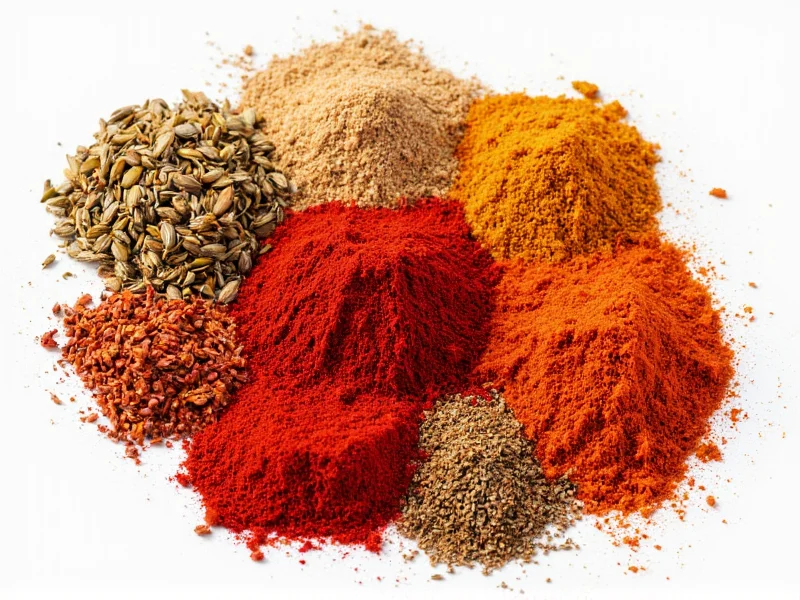Creating exceptional chili depends on understanding how spices interact with meat, beans, and tomatoes. The right spice blend balances heat, earthiness, sweetness, and complexity while enhancing rather than overwhelming the core ingredients. Professional chefs and home cooks alike recognize that spice selection and technique separate memorable chili from ordinary batches.
Core Spices That Define Chili Flavor
These foundational spices create the distinctive profile that identifies a dish as chili. Understanding their individual contributions helps you adjust recipes to your taste preferences while maintaining authenticity.
| Spice | Flavor Profile | Recommended Amount (per lb meat) | Best Added |
|---|---|---|---|
| Chili Powder | Earthy, moderately spicy, slightly sweet | 2-3 tablespoons | Beginning of cooking |
| Cumin | Warm, earthy, slightly smoky | 1-2 teaspoons | With chili powder |
| Paprika | Sweet, mild, rich color | 1-2 tablespoons | Beginning of cooking |
| Dried Oregano | Herbal, slightly bitter, earthy | 1 teaspoon | Middle of cooking |
Chili Powder: The Essential Foundation
Despite its name, chili powder isn't just ground chilies—it's typically a blend containing cumin, garlic powder, oregano, and paprika. High-quality chili powder provides the signature flavor that defines the dish. When selecting chili powder, look for varieties labeled "ancho" or "New Mexico" for authentic regional flavors. For best results, bloom chili powder in hot oil for 1-2 minutes before adding liquids—this technique unlocks deeper flavors through the Maillard reaction.
Cumin: The Warmth Builder
Cumin's distinctive earthy warmth forms the backbone of chili flavor. Whole cumin seeds toasted and freshly ground provide significantly more complex flavor than pre-ground versions. The compound cuminaldehyde gives cumin its characteristic aroma that complements beef and beans perfectly. Professional chili makers often use slightly more cumin than recipes suggest, as its flavor mellow and integrate beautifully during simmering. For vegetarian chili, increase cumin slightly to compensate for the absence of meat's natural umami.
Paprika: Color and Sweet Balance
Paprika serves dual purposes in chili: providing rich red color and balancing heat with natural sweetness. Hungarian sweet paprika creates the classic chili appearance without excessive heat, while smoked paprika adds depth for those avoiding liquid smoke. The carotenoids in paprika not only create visual appeal but also help emulsify the sauce, creating a more cohesive texture. When using hot paprika, reduce cayenne proportionally to maintain balanced heat levels.
Supporting Spices for Complexity
These secondary spices enhance the core profile without dominating. Used judiciously, they create nuanced layers that distinguish exceptional chili.
Dried Oregano: The Herbal Note
Mexican oregano (different from Mediterranean varieties) contributes a subtle citrusy note that cuts through richness. Unlike its Italian counterpart, Mexican oregano has earthier, less sweet characteristics that complement chili perfectly. Add toward the middle of cooking to preserve its volatile oils. For authentic Texas-style chili, use sparingly—some traditionalists consider oregano non-essential.
Garlic and Onion Powder: The Flavor Base
While fresh garlic and onion have their place, powdered forms distribute flavor more evenly throughout chili. Their concentrated nature withstands long cooking times better than fresh versions. The sulfur compounds in these powders create savory depth that mimics the effect of a long-simmered mirepoix. For best results, add with your core spices to allow proper flavor integration.
Cayenne Pepper: Precision Heat Control
Cayenne provides adjustable heat without altering the fundamental flavor profile. Unlike chili powder which offers complex flavor with heat, cayenne delivers pure capsaicin punch. Start with 1/8 teaspoon per pound of meat and adjust upward after 30 minutes of simmering. Remember that heat perception increases as chili sits, so under-season slightly if serving later.
Advanced Spice Techniques
Professional chili makers employ these techniques to maximize spice potential:
Layering Spices Throughout Cooking
Add 70% of your core spices at the beginning to build foundational flavor, then finish with 30% near the end to preserve brighter notes. This creates dimensional spice perception rather than a single-note profile. Whole spices like cumin seeds added early provide different flavor notes than ground versions added later.
Acid Balance for Spice Enhancement
A splash of vinegar, lime juice, or even coffee added near the end brightens spice flavors that may have mellowed during cooking. The acid interacts with spice compounds, making them more perceptible to your palate. Add acid gradually—1 tablespoon at a time—until flavors 'pop' without becoming tart.
Regional Spice Variations
Authentic chili styles showcase distinctive spice approaches:
- Texas Red: Minimal spices beyond chili powder, cumin, and garlic—focuses on meat flavor
- Cincinnati Style: Includes cinnamon and unsweetened chocolate for complexity
- New Mexico: Features local red and green chilies with minimal additional spices
- Midwest: Often includes mustard powder and Worcestershire for tang
Spice Freshness and Storage
Stale spices ruin otherwise perfect chili. Ground spices lose potency within 6 months, while whole spices last 1-2 years. Store spices in airtight containers away from light and heat. Test potency by rubbing a small amount between your fingers—if the aroma is weak, replace them. For critical dishes, toast whole spices and grind them fresh. Properly stored, high-quality spices maintain their chemical compounds that create distinctive flavor profiles essential for exceptional chili.











 浙公网安备
33010002000092号
浙公网安备
33010002000092号 浙B2-20120091-4
浙B2-20120091-4